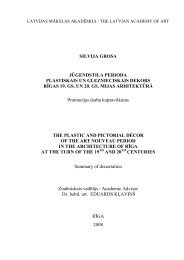Institute of Art History of the Latvian Academy of Art Anna Ancāne ...
Institute of Art History of the Latvian Academy of Art Anna Ancāne ...
Institute of Art History of the Latvian Academy of Art Anna Ancāne ...
You also want an ePaper? Increase the reach of your titles
YUMPU automatically turns print PDFs into web optimized ePapers that Google loves.
V. 2.2. Bell-shaped gables predominated in Riga’s urban landscape<br />
during <strong>the</strong> last two decades <strong>of</strong> <strong>the</strong> 17 th century, mostly in <strong>the</strong> districts to<br />
<strong>the</strong> right from Kaļķu Street. Bell-shaped gables were <strong>the</strong> largest group;<br />
such examples have survived at 10 Tirgoņu Street and 11 Miesnieku<br />
Street. These gables were widely represented at Tirgoņu Street as well as<br />
at Jēkaba, Mazā Pils, Mazā Jaunavu, Smilšu, Laipu Streets, etc. In <strong>the</strong><br />
Ne<strong>the</strong>rlands <strong>the</strong>se gables evolved from step-shaped volute gables and <strong>the</strong><br />
so-called neck gables (halsgevel), but a wide variety <strong>of</strong> local versions<br />
emerged in Nor<strong>the</strong>rn Europe. In Riga just several examples <strong>of</strong> neck<br />
gables have been detected – at 20 Tirgoņu Street, 1 Jēkaba Street and 2<br />
Šķūņu Street. The most part <strong>of</strong> bell-shaped gables had a ra<strong>the</strong>r moderate<br />
décor: dynamic silhouettes were topped by small pediments. Slopes <strong>of</strong><br />
bell-shaped gables were sometimes complemented with volutes (at <strong>the</strong><br />
corner <strong>of</strong> Šķūņu and Laipu Streets) or projecting garlands <strong>of</strong> fruits and<br />
flower buds.<br />
V.2.3. Volute gables are <strong>the</strong> second largest group whose roots are found<br />
in <strong>the</strong> geography <strong>of</strong> Dutch influences. Unlike in <strong>the</strong> Ne<strong>the</strong>rlands, in Riga<br />
stepped volute gables were not a transitional stage but an established<br />
gable type that does not undergo fur<strong>the</strong>r evolution. Bell-shaped gables<br />
with elongated side volutes that represented <strong>the</strong> next developmental stage<br />
in <strong>the</strong> Ne<strong>the</strong>rlands coexisted with stepped volute gables in Riga – this<br />
could be a sign <strong>of</strong> conservatism and local peculiarity. The traditional<br />
route <strong>of</strong> influences – <strong>the</strong> Ne<strong>the</strong>rlands–Nor<strong>the</strong>rn Germany–Eastern Baltic<br />
– can be expanded, comparing Riga’s volute gables with <strong>the</strong> Nuremberg<br />
architect Jacob Wolf die Älder’s projects <strong>of</strong> rich gabled houses.<br />
Representative volute gables were very common in newly built houses in<br />
<strong>the</strong> last quarter <strong>of</strong> <strong>the</strong> 17 th century, especially in <strong>the</strong> 1690s. The façade<br />
was plastered and coloured, so <strong>the</strong> Baroque volute gables took on<br />
monumentality. The silhouette <strong>of</strong> <strong>the</strong> gable was <strong>the</strong> main bearer <strong>of</strong><br />
decorativeness.<br />
Gables contoured by stepped volutes<br />
The very popular gables with ra<strong>the</strong>r small, stepped volutes that were very<br />
decorative and cascaded one after ano<strong>the</strong>r on <strong>the</strong> entire slope,<br />
demonstrated a civic and economic attitude (at 20 Mazā Kalēju Street, 22<br />
Mārstaļu Street, 32 Grēcinieku Street (1681), 15, 18 and 24 Mārstaļu<br />
Street (1 st half <strong>of</strong> <strong>the</strong> 1680s)). The example <strong>of</strong> Wismar in Mecklenburg<br />
shows that cascades <strong>of</strong> volutes are found in both <strong>the</strong> 1670s and 1680s and<br />
on <strong>the</strong> threshold <strong>of</strong> <strong>the</strong> 18 th century. In Riga <strong>the</strong> “loose silhouette” gables<br />
with small stepped volutes existed already from <strong>the</strong> 1660s.<br />
In <strong>the</strong> most lavish gables monumental volutes intertwined with acanthus<br />
ornament were grouped symmetrically on two or three levels. This<br />
variation can be attributed to <strong>the</strong> last decade <strong>of</strong> <strong>the</strong> 17 th century when <strong>the</strong>y<br />
became top modern. Their contours feature Baroque dynamism and<br />
21












